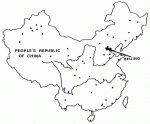The institutes of the Chinese Academy of Sciences (CAS) maintain approximately 100 field stations throughout China. Fifty-six of the field stations (see map) are involved in geosphere-blosphere studies. Based on the represented ecosystems, scientific teams, research programs, and facilities, CAS will choose 20 stations that will compose a LTER Network. The time frame for setting up the Chinese LTER Network is approximately 7 years.
Objectives of the program are to:
- Understand the structure, function, succession, and productivity of both natural and man-made ecosystems
- Find approaches that will improve the protection and management of those ecosystems
- Make management demonstrations for local people
- Observe and monitor eco-environment and ecosystem changes
Three sub-networks which will be established in the LTER Network are:
- Forest ecosystem site network, sponsored by the Institute of Applied Ecology (IAE), of the CAS in Shenyang
- Agro-ecology site network, also sponsored by IAE, CAS
- Grassland ecosystem site network, sponsored by the Institute of Botany, CAS
The LTER program will be part of China’s participation in the International Geosphere/Blosphere Program (IGBP) study in the long term. Results of the work will also be used for ecosystem management by local people in the short term.
The entire program will be funded by CAS and sponsored by IAE, GAS.
For information contact Dr. Zhou Shidong, Institute of Applied Ecology, Chinese Academy of Sciences, Shenyang, People’s Republic of China.

 Enlarge this image
Enlarge this image